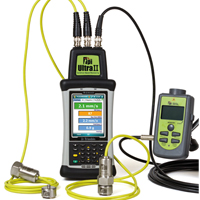 Condition Monitoring Beats Planned Maintenance
Condition Monitoring Beats Planned MaintenanceCompanies have never been more aware of the large costs and inconveniences created by downtime and urgent repair when equipment fails unexpectedly.
However in an effort to prevent this, many are still exclusively reliant on routine maintenance, which is not only a fixed recurring cost in itself, but often results in work and replacement of components whether needed or not! The other major disadvantage of routine maintenance is getting the service interval right. Too often, and it becomes expensive and possibly invites faults through ‘over inspection’, but not often enough increases the likelihood of unexpected breakdowns!
Alternatively, in the same way that some modern cars now have intelligent, variable service intervals, those responsible for manufacturing plant and building equipment can utilise condition based maintenance (CBM) strategies. By regularly monitoring the condition, or degree of wear in a machine, a far smarter strategy can be applied to maintenance and service. For example, instead of routinely removing a machine and dismantling it to replace bearings, the work can instead be performed only as required and when indicated by increases in the machine’s vibration levels. It is certain that once a bearing’s vibration ‘signature’ starts to increase due to noise it will only increase further – and often at an exponential rate. Bearings never become less worn! Consequently, CBM can provide an early warning of unexpected and catastrophic mechanical failures, which are always a risk of routine maintenance schemes.
In addition to the above, by monitoring and therefore maximising machine efficiency, energy usage can be optimised. Vibration, regardless of the cause or source will increase the load on a motor or pump. For example, monitoring a machine’s condition over time can reveal that its vibration has increased. With the right equipment to detect it, an increase in low frequency vibration at two times the run speed would suggest a misalignment. Addressing the problem can achieve a significant reduction in overall low frequency vibration and in turn a significant decrease in power usage and resulting increase in efficiency.
Clearly then, condition based maintenance can save money by allowing maintenance to be performed when it is actually required, thus avoiding the greatest cost of all – unexpected emergency repairs, as well as by reducing energy consumption. So why isn’t everyone using CBM? In the U.S.A. use of CBM has been in place much longer, and is far more mature than in Europe. Until recently there has been a perception that CBM is expensive and complex, possibly with some justification. But not anymore and its adoption is rapidly becoming widespread. As European manufacturing plants and facility managers increasingly benefit from CBM it is imperative that their CBM equipment is straightforward to use and provides clear, colour coded alarms that any operator can act upon with confidence. Thankfully these devices are now widely available.
Typical examples include the Test Products International (TPI) range of low cost, high performance, easy to use vibration analysis tools for maintenance engineers. From the simple ‘one-button-to-press’ TPI 9070 vibration analyser to ‘top-of-the-range’ units for condition based and predictive maintenance, machine balancing and alignment, TPI’s products are all incredibly easy to use. The TPI 9080 (also available with ATEX certification) is the latest in a line of easy to use high specification maintenance products offering high level functionality and capability at extremely low cost. The TPI 9080 is capable of storing equipment routes (as simple lists) that can be followed by even the lowest skilled operative to collect and store vibration readings for transfer to the included VibTrend PC trending software. This allows faults such as out of balance, misalignment, looseness and worn bearings to be identified well ahead of the point at which they start to become a problem.
For more information visit:
www.tpieurope.com



